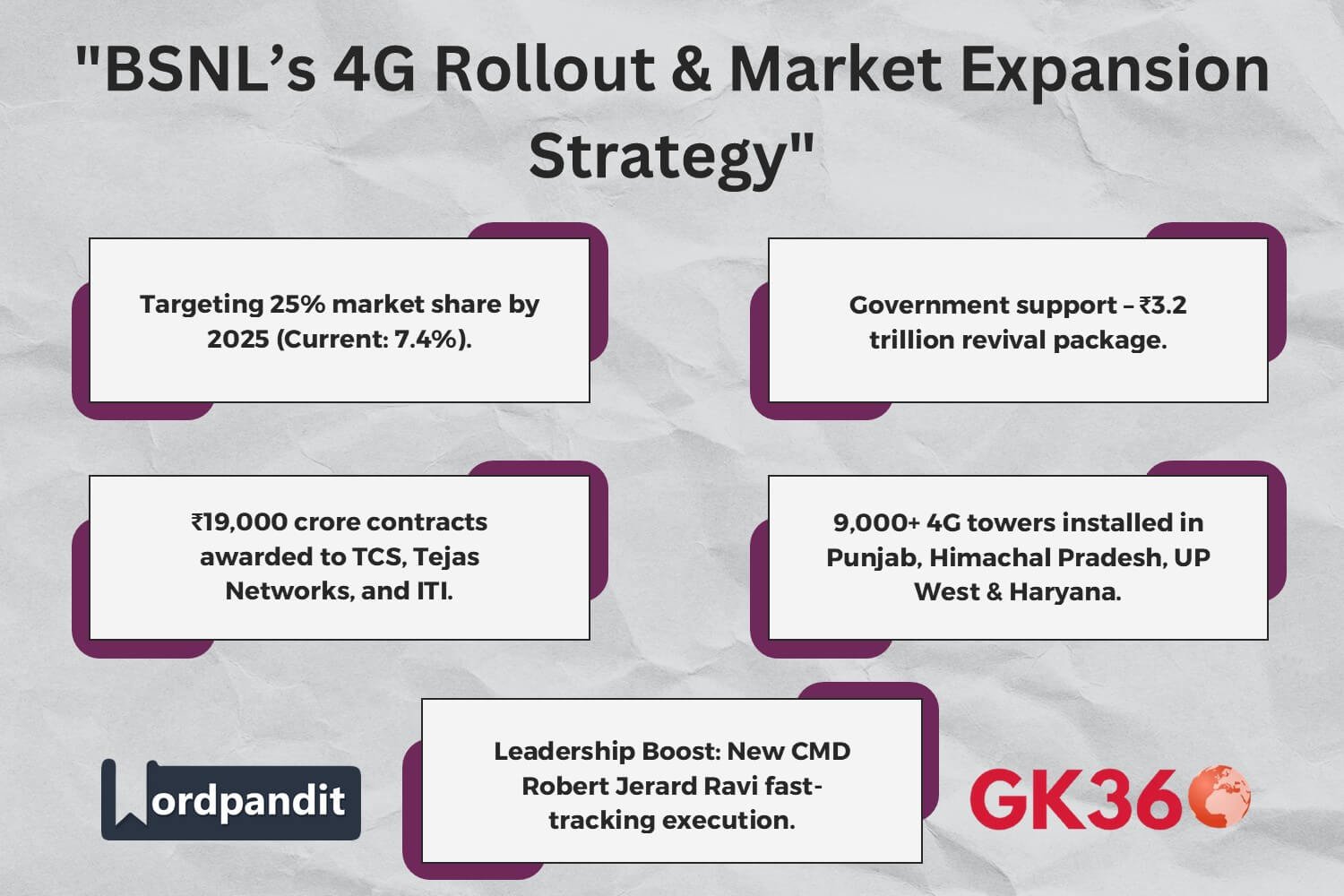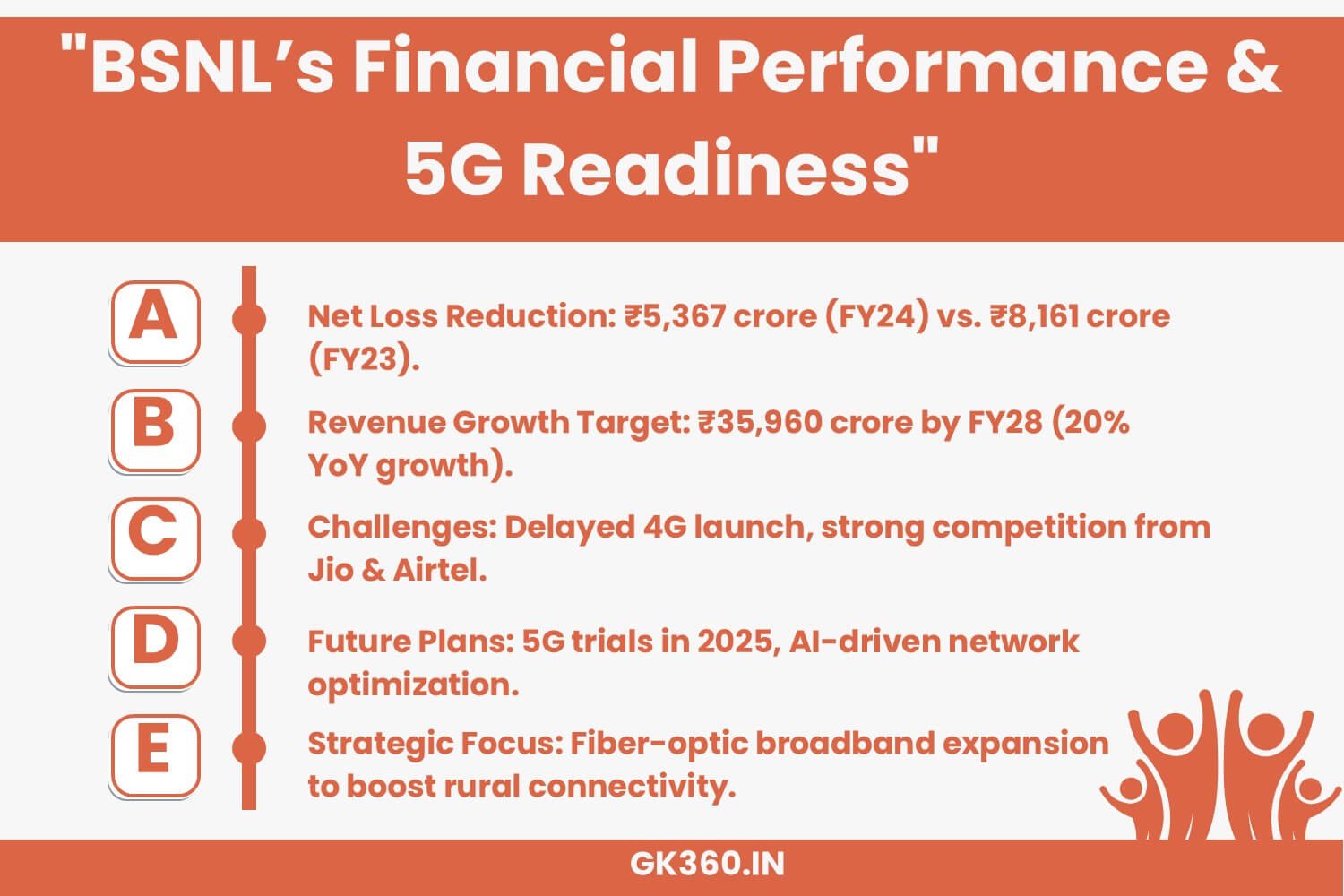BSNL’s 4G Revolution: Government Support, Market Share Goals, and Future of Telecom in India
Introduction
Bharat Sanchar Nigam Limited (BSNL) is making a bold move in the Indian telecom sector, aiming to secure 25% market share by 2025 as it aggressively rolls out 4G services. With a current market share of 7.4% and 86.3 million mobile subscribers, this target signals BSNL’s commitment to regaining its competitive edge.
Supported by government-backed revival plans, strategic partnerships, and an ambitious technology upgrade, BSNL is poised to reshape the telecom industry. This article explores BSNL’s 4G expansion strategy, financial backing, leadership initiatives, and future growth prospects.

Table of Contents
- Government Support and Financial Backing
- BSNL’s 4G Rollout and Infrastructure Development
- Leadership and Strategic Focus
- BSNL’s Financial Performance
- Challenges in Achieving Market Goals
- Future of BSNL: 5G Readiness and Growth Plans
- FAQs
- Conclusion
Government Support and Financial Backing
The Indian government has prioritized BSNL’s revival, allocating an unprecedented ₹3.2 trillion in revival packages. A significant ₹83,416 crore has been earmarked in the 2024-25 Budget for technological upgrades, restructuring, and network expansion.
Key Financial Support Elements:
- ✔ Debt Reduction Measures: To ease financial burden and facilitate expansion.
- ✔ Infrastructure Modernization: Upgrades in core telecom technologies, including 4G and 5G readiness.
- ✔ Operational Efficiency Improvement: Streamlining business processes to reduce costs and enhance service delivery.
➡ Why This Matters?
For competitive exam aspirants, understanding government investment in state-owned enterprises (SOEs) like BSNL provides insights into economic policies and infrastructure development.
BSNL’s 4G Rollout and Infrastructure Development
BSNL is aggressively expanding its 4G network, awarding contracts worth ₹19,000 crore to leading tech firms, including Tata Consultancy Services (TCS), Tejas Networks, and ITI.
Current Deployment Progress:
- ✔ 9,000+ 4G towers installed in key regions, including Punjab, Himachal Pradesh, UP West, and Haryana.
- ✔ Project Management Unit (PMU) established to monitor daily deployment progress in collaboration with TCS, Tejas Networks, and C-DOT.
➡ Exam Insight:
Key players and regions involved in major telecom projects like BSNL’s 4G rollout are critical for general knowledge and current affairs sections.
Leadership and Strategic Focus
Robert Jerard Ravi has assumed the role of Chairman and Managing Director (CMD) of BSNL for a six-month tenure. His strategic priorities include:
- ✔ Fast-tracking the 4G rollout
- ✔ Launching 5G trials
- ✔ Reducing subscriber churn rate
- ✔ Enhancing customer service and network quality
➡ Real-Life Application:
Leadership changes in major corporations influence business strategies and industry growth. This is a crucial topic for competitive exams focused on business and current affairs.
BSNL’s Financial Performance
BSNL has demonstrated financial improvement, reducing its net loss to ₹5,367 crore in FY24, compared to ₹8,161 crore in FY23. However, revenue from operations grew by only 1% to ₹19,343.6 crore, missing the target of ₹20,008 crore.
Future Revenue Projections:
- ✔ ₹35,960 crore revenue target by 2027-28.
- ✔ 20% year-on-year growth expected from FY25 to FY27.
➡ Key Takeaway:
Financial performance metrics of public sector enterprises are often tested in competitive exams, making it essential to understand their growth trends and challenges.
BSNL’s Financial Performance
BSNL has demonstrated financial improvement, reducing its net loss to ₹5,367 crore in FY24, compared to ₹8,161 crore in FY23. However, revenue from operations grew by only 1% to ₹19,343.6 crore, missing the target of ₹20,008 crore.
Future Revenue Projections:
- ✔ ₹35,960 crore revenue target by 2027-28.
- ✔ 20% year-on-year growth expected from FY25 to FY27.
➡ Key Takeaway:
Financial performance metrics of public sector enterprises are often tested in competitive exams, making it essential to understand their growth trends and challenges.
Challenges in Achieving Market Goals
Despite strong government backing, BSNL faces several obstacles:
- 🔴 Delays in 4G Rollout: Private telecom operators already dominate the market, making BSNL’s delayed launch a significant disadvantage.
- 🔴 High Competition: Jio, Airtel, and Vi have strong infrastructure and customer bases, challenging BSNL’s market expansion.
- 🔴 Customer Retention Issues: BSNL must improve network quality and customer service to reduce subscriber churn.
- 🔴 5G Readiness: While competitors are launching 5G services, BSNL’s 5G trials are still in early phases.
➡ Strategic Outlook:
Overcoming these challenges will determine BSNL’s ability to achieve its 25% market share target.
Future of BSNL: 5G Readiness and Growth Plans
BSNL is preparing for the 5G era, with trials expected to commence in late 2025. The company is focusing on:
- ✔ Integrating 4G and 5G infrastructure for a seamless transition.
- ✔ Expanding fiber-optic broadband services to strengthen rural connectivity.
- ✔ Leveraging AI-driven network optimization for improved service delivery.
➡ Exam Perspective:
Understanding 5G technology adoption and BSNL’s digital transformation can be crucial for technology-based exam sections.

FAQs
1. Why is BSNL launching 4G now, when private players have already moved to 5G?
BSNL’s delayed 4G rollout is part of its revival strategy, backed by government funding. The company plans to launch 5G services after establishing a strong 4G network.
2. How will BSNL compete with Jio and Airtel?
BSNL is leveraging affordable pricing, improved service quality, and government support to regain market share.
3. What is the government’s role in BSNL’s revival?
The Indian government has invested ₹3.2 trillion in financial support, including debt relief and infrastructure modernization.
4. Will BSNL’s 4G expansion improve rural connectivity?
Yes, BSNL is focusing on expanding fiber-optic broadband and rural telecom services to bridge the digital divide.
5. What are BSNL’s revenue goals for the future?
BSNL aims to achieve ₹35,960 crore in revenue by 2027-28, with a 20% year-on-year growth target.
Conclusion
BSNL’s 4G rollout and revival strategy mark a crucial phase in its transformation. With substantial government support, strong leadership, and a clear focus on innovation, BSNL is working towards reclaiming its position in the telecom industry.
For competitive exam aspirants, staying updated on major economic policies, infrastructure developments, and digital transformation efforts like BSNL’s can provide a valuable edge.
Key Takeaways Table
| Aspect | Details |
|---|---|
| Market Share Target (2025) | 25% (Current: 7.4%) |
| Government Support | ₹3.2 trillion revival package |
| 4G Rollout Investment | ₹19,000 crore (TCS, Tejas Networks, ITI) |
| Current Network Deployment | 9,000+ towers installed |
| Financial Performance (FY24) | Net loss reduced to ₹5,367 crore |
| Revenue Target (2028) | ₹35,960 crore (20% YoY growth) |
| Challenges | Late 4G launch, competition from Jio & Airtel |
| 5G Plans | Trials in 2025, AI-driven optimization |
Related terms
- BSNL 4G Expansion 2025
- BSNL Market Share Growth
- BSNL Government Revival Package
- India Telecom Industry Trends
- BSNL vs Jio vs Airtel
- BSNL 5G Plans and Rollout
- BSNL Financial Recovery 2024
- Digital Transformation in India Telecom
- BSNL Network Expansion Strategy
- BSNL Revenue Growth Forecast





